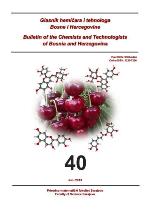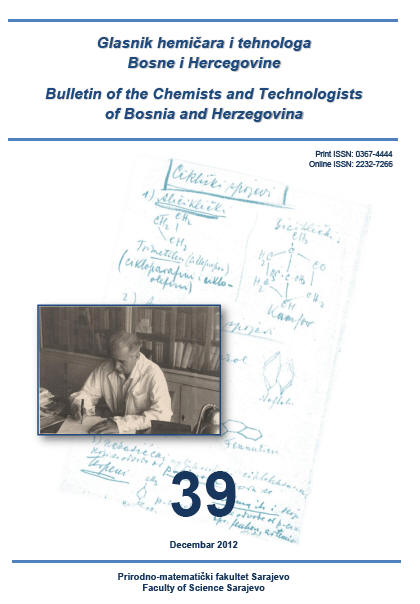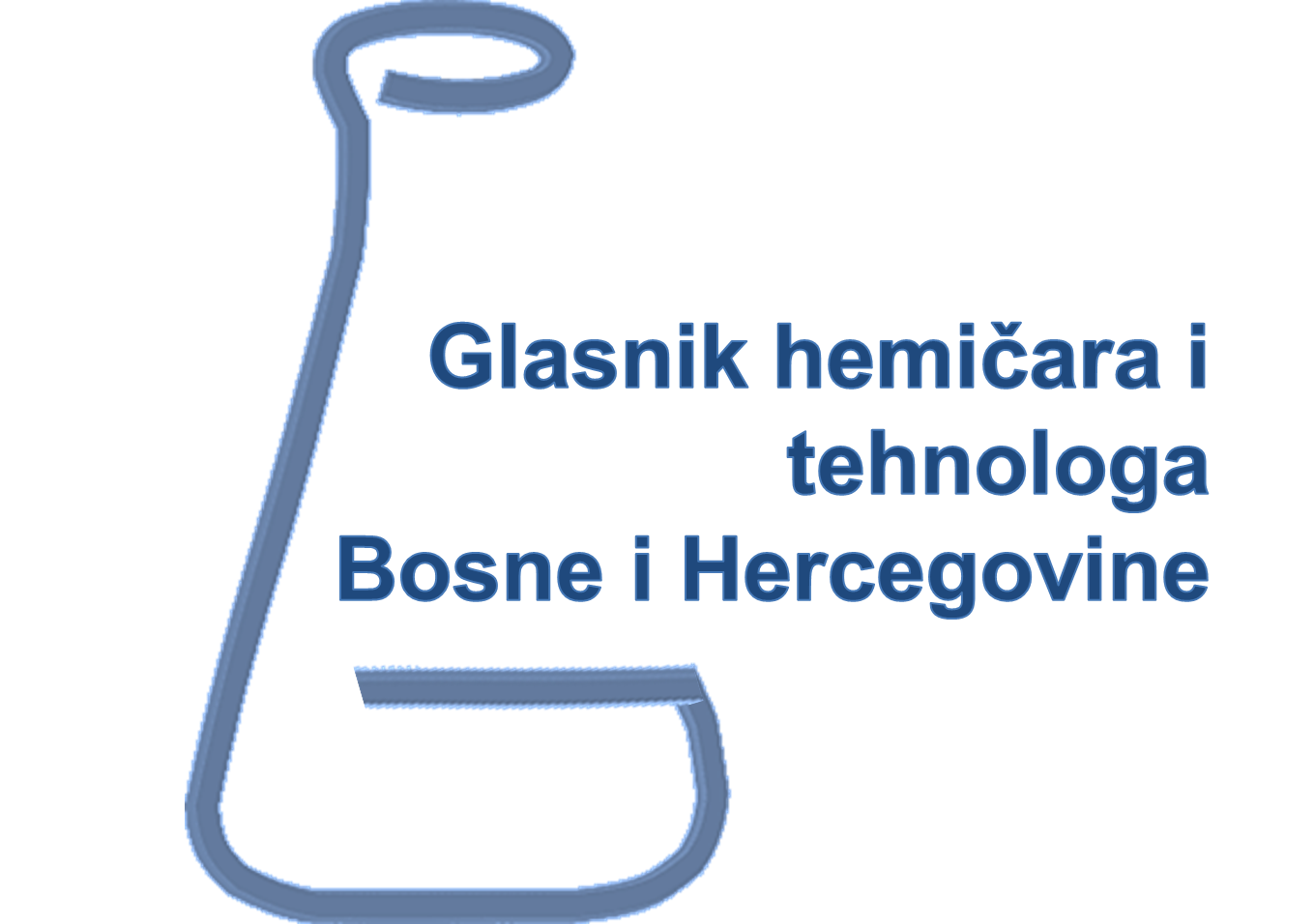|
|
Bulletin of the Chemists and Technologists of Bosnia and Herzegovina
Issue 40
Publication date: June 2013 |
Table of contents
Myeloperoxidase Interactions with Nitric Oxide: A Review of Mechanistic Pathways Review
Galijašević Semira
Abstract: The phagocytic enzyme myeloperoxidase (MPO) plays an essential role in the inflammatory response by catalyzing formation of reactive species involved in microbial killing by generating hypochlorous acid (HOCl) from H2O2 and physiological (≥100 mM) Cl- concentrations. However, increased MPO activity has been linked to a number of pathologies with compelling evidence in initiation and progression of inflammatory events. For example, leukocyte and serum MPO levels are elevated in patients with coronary artery disease and thus may be used as a marker for cardiovascular events. MPO-derived oxidants have been linked with neurodegenerative disorders, carcinogenesis, lung disease and respiratory damage, rheumatoid arthritis, kidney damage and atherosclerosis, respectively. Recent data showed the link between increase levels of MPO and development of diabetes, implicating the enzyme as a catalyst for oxidative reactions in the vascular wall. One of the important molecules directly modulated by MPO is nitric oxide, whose bioavailability plays the central role in the development of different pathophysiologies. Thus, we reviewed and analyzed available data and proposed the comprehensive reaction pathways connecting inflammatory action of MPO and bioavailability of NO resulting in a major disturbance of normal psychological functions.
Bulletin of the Chemists and Technologists of Bosnia and Herzegovina 40, 1-8.
Structure of Matter – Diagnosis of Misconceptions and Challenge Review
Barke Hans-Dieter
Abstract: Students at schools and universities may know formulae and chemical equations, but are weak in mental models according the structure of metal- and salt crystals. Especially concerning ions as particles in solid salts or in salt solutions they show a lot of misconceptions, i.e. NaCl molecules in rock salt or Na-O-H molecules in sodium hydroxide solution. One way to challenge those misconceptions can be a periodic table containing symbols of atoms and ions on the base of Daltons atomic model, showing atoms and ions by spheres of different sizes. Combining metal atoms “left and left in PSE” to giant structures will show structures of pure metal crystals and alloys, combining nonmetal atoms “right and right in PSE” to molecules will show molecular structures of volatile substances, combining ions “left and right in PSE” will show ionic lattices of salt crystals. With those steps in early chemistry education the understanding of salts and electrolyte solutions will be scientifically correct – misconceptions should be minimized.
Bulletin of the Chemists and Technologists of Bosnia and Herzegovina 40, 9-16.
Cyclic Conjugation in Benzo-annelated Ovalenes Original Scientific Article
Gojak-Salimović Sabina, Gutman Ivan, Đurđević Jelena, Janošević Marina
Abstract: The effect of small structural changes on the electronic properties of large benzenoid molecules is studied in the case of ovalene and its benzo-annelated derivatives. Two quantitative indicators of the intensity of cyclic conjugation in individual rings were used: the π-electron content and the energy effect. Most regularities observed can be rationalized by means of the classical Clar aromatic sextet theory, although a few second-order effects point towards the need to go beyond the Clar model.
Bulletin of the Chemists and Technologists of Bosnia and Herzegovina 40, 17-20.
Influence of Monomer Concentration on Capability of Voltammetric Polypyrrole Based Cation Sensor Using Modified Butler-Volmer Equation Original Scientific Article
Ostojić Jelena, Gojak-Salimović Sabina, Korać Fehim, Gutić Sanjin, Islamović Safija
Abstract: In this work, a modified Butler-Volmer equation is used to determine capability of voltammetric ion sensor based on modified PPy/DBS electrode. This method shows a direct relationship between mid point reversible potential (ER) and the logarithm of the electrolyte concentration. Slopes from Butler-Volmer equation include electron-transfer coefficient. Modified PPy/DBS electrode was successfully applied as voltammetric cation sensor. It was shownthat the capability of the sensor depends on the quality of formed polypyrrole film which is dependent on the initial monomer concentration.
Bulletin of the Chemists and Technologists of Bosnia and Herzegovina 40, 21-24.
Identification and Quantification of Quercetin, Naringenin and Hesperetin by RP LC – DAD in Honey Samples from B&H Original Scientific Article
Kurtagić Harun, Redžić Sulejman, Memić Mustafa, Sulejmanović Jasmina
Abstract: A large number of different products on the market comes under the name of honey, but many of them are false. Presence of flavonoids in the honey samples may be an indication of its origin. There for ethere is a need for reliable analytical methods for identification and quantification of flavonoids in the honey samples. Flavonoids as constituents of many plants, bees bringto the hive through pollen and honey dew. In this work, identification and quantification of three flavonoids: quercetin, naringenin and hesperetin from twelve honey samples of different botanical origin from Bosnia and Herzegovina were performed. The samples were collected during the period July-September,2010. Reverse phase liquid chromatography coupled with diode array detector (RP LC-DAD) has been used to separate flavonoids and to quantify them in extractive solutions from honey samples. Results showed that the highest amount of quercentin (43.28 μg/100 g honey) and hesperetin (50.12 μg/100 g honey) was found in honey acacia (K2) and naringenin (41.40 μg/100 g honey) in the linden. The highest total content of all investigated flavonoids was 122.40μg/100 g honey in sample of honey acacia (K2).
Bulletin of the Chemists and Technologists of Bosnia and Herzegovina 40, 25-30.
Thermal and Crystallographic Characteristics of Synthesized Xanthen-3-one Derivatives Original Scientific Article
Završnik Davorka, Veljović Elma, Bajrović Adnan, Vrankić Martina, Gržeta Biserka, Osmanović Amar, Špirtović-Halilović Selma, Muratović Samija
Abstract: Series of synthesized xanthen-3-one derivatives were analyzed for thermal characteristics by differential scanning calorimetry (DSC), as well as for crystallinity using X-ray powder diffraction. Xanthen-3-one derivatives are prepared according to the well known procedure, which includes two-fold Friedel-Crafts alkylation. The aim of this research was to determine purity and crystallinity of synthesized xanthen-3-one derivatives.Thermograms of synthesized compounds showed that compounds have purity above 98%, while crystallographic analysis of powder showed that thecompounds have a10-37% monocrystallineform.
Bulletin of the Chemists and Technologists of Bosnia and Herzegovina 40, 31-34.
Changein Acidity of L-Ascorbic Acid in the Mixed Solvent DMSO- Water Followed by Conductometric Determination of Dissociation Constants Original Scientific Article
Rimpapa Zlatan, Pleho-Kapić Amna, Galijašević Semira, Šapčanin Aida, Korać Fehim
Abstract: Using conductometric method, the changes in the acidity of L-ascorbic acid in the mixed solvent dimethylsulfoxide (DMSO) - water were monitored. The mixed solvent used was two-component system consisting of nonpolar and polar solvents. Dissociation constants of L-ascorbic acid was determined in pure water and in the mixed solvent DMSO- water with different molar ratios of two solvents: xDMSO=0.500, 0.333, 0.250, 0.200, 0.166, corresponding respectively to DMSO -H2O, DMSO-2H2O; DMSO-3H2O,DMSO-4H2O; DMSO-5H2O. Concentrations of freshly prepared solution of ascorbic acid were in the range from 0.00002 to 0.05 moldm-3. Molar conductivity resistance values were measured for a given concentration of freshly prepared solutions of L-ascorbic acid and 24 hours old solutions. Using Ostwald's dilution law values for the molar conductivity at infinite dilution (l0) and dissociation constants (K), i.g. pK(-log K) were calculated. The results obtained for different concentrations of L-ascorbic acid in the mixed solvent DMSO - water indicate that during a time, pK values declined and acidity increased. Following pK values in the dependence on xDMSO for a freshly prepared solution of L-ascorbic acid. The curve with two inflection points was obtained corresponding to the system of mixed solvent DMSO and DMSO-2H2O and DMSO-3H2O. In 24 hours old solution of L-ascorbic acid, inflection points were not observed. The results indicate the possibility of different adducts in the mixed solvent or in old solutions as well as accumulation of degradation products over time.
Bulletin of the Chemists and Technologists of Bosnia and Herzegovina 40, 35-38.
Energy Consumption and Environmental Impact of the Foundry Industry Original Scientific Article
Šehić-Mušić Nafija, Goletić Šefket,Pihura Derviš, Mušić Lejla, Hasanović Kadrija, Kalajdžisalihović Aida
Abstract: Climate change has a negative effect on water and food production, which poses a serious problem, as both resources are necessary for human survival. Sustainable development is the basic approach to the environment in modern times. Energy consumption and environmental issues such as climate change are global problems and industries such as the foundry industry have an influence over them. Therefore, environmental awareness, eco ethics, bioethics, and social reflexivity can be the agents of change in the future.Integrating the environment into development issues is of particular importance in the industry, so the aim of the research in this paper is to define a model for implementation and monitoring of key indicators of energy efficiency, as an instrument of effective environmental and energy management in the metal sector of Bosnia and Herzegovina. Using these environmental tools contributes to more efficient use of energy as well as reducing emissions and negative impact on the environment. The study includes mezzo level companies (foundries).
Bulletin of the Chemists and Technologists of Bosnia and Herzegovina 40, 39-46.
Treatment of Antimony-Rich Waste Streams Original Scientific Article
Avdić Nurudin, Müller-Czygan Günter
Abstract: The use of antimony in various chemical industries represents a potential source of environmental pollution, that occurs by discharg of untreated wastewater generated in the watercourses. Another sources of this pollutants can be individual sources from improper recycling of products containing antimony as, for example, of old batteries containing antimony in the bars and in the electrolyte.Here, it is suggested to extract antimony from waste water, with the possibility of application to different flows and concentrations of metals.
Bulletin of the Chemists and Technologists of Bosnia and Herzegovina 40, 47-49.
100 Years Anniversary of the Bohr Model ofthe Atom: How Chemistry Freshmen Understand Atomic Structure of Matter Original Scientific Article
Hadžibegović Zalkida, Galijašević Semira
Abstract: Hundred years ago the Danish physicist Niels Bohr presented his model of the atom for what he received Nobel Prize. His theory led to the revolutionary development of science in the beginning of 20th century. Later one, quantum mechanics developed a new theory explaining all the shortcomings of Bohr’s model. However Bohr’s atom theory is presented and studied in most introductory General Chemistry textbooks. This anniversary was an opportunity to see how science students understand and visualize the structure of the atom. The data reported in this paper derived from a pilot research with 58 chemistry freshmen, were collected to explore their ideas of an atom, their knowledge about the Bohr model of the atom, and history and philosophy of science approach to Bohr atomic theory. Students' knowledge about Bohr's postulates is in agreement with chemistry textbook content except the part about Bohr's idea of angular momentum quantization, which they discuss within the General Physics 2 course. Using historical point of view when studying Bohr’s theory and his model of the hydrogen atom can help students to understand contemporary theory of the atom better.
Bulletin of the Chemists and Technologists of Bosnia and Herzegovina 40, 51-56.
Influence of Hydroxypropyl Guar on Water Retention of Cement Based Renders Technical Article
Medić Vesna
Abstract: Cellulose ethers are polymers introduced into mortar formulations to improve thickening and water retention capacity. Cellulose industry require technology with chemicals treatment which causes the production of industrial wastewater and made this industry for one of the largest pollutants of water and air. This work present the analysis of possibile application of the guar beans powder in cement based renders for partical replacement of the cellulose ether. Technology of basic guar bean powder production is very simple process and present only mechanical operations which don't include a chemical treatments that causes pollutant effects to ecology. Experimental part involves a meassurement of water retention capacity in freshly mixed cement based render independency of quantity of aplicient hydroxypropyl guar. For measuring are Filter plates and conical plastic rings according to EN 459-2 were used for measurements. The results are presented as mass percente of hydroxypropyl guar (HPG) which can be replaced with hydroxyethyl methyl cellulose (HEMC) including high water retention capacity in optimal conditions of used water for preparing fresh mixed mortars. Thereby, the possibility for decraseing consuption of celluloseused in t building material products and constructions has been established which can improve a positive effect by decreasing wood exploatation and decreasing enviromental pollutants.
Bulletin of the Chemists and Technologists of Bosnia and Herzegovina 40, 57-60.





 Full text PDF
Full text PDF 





